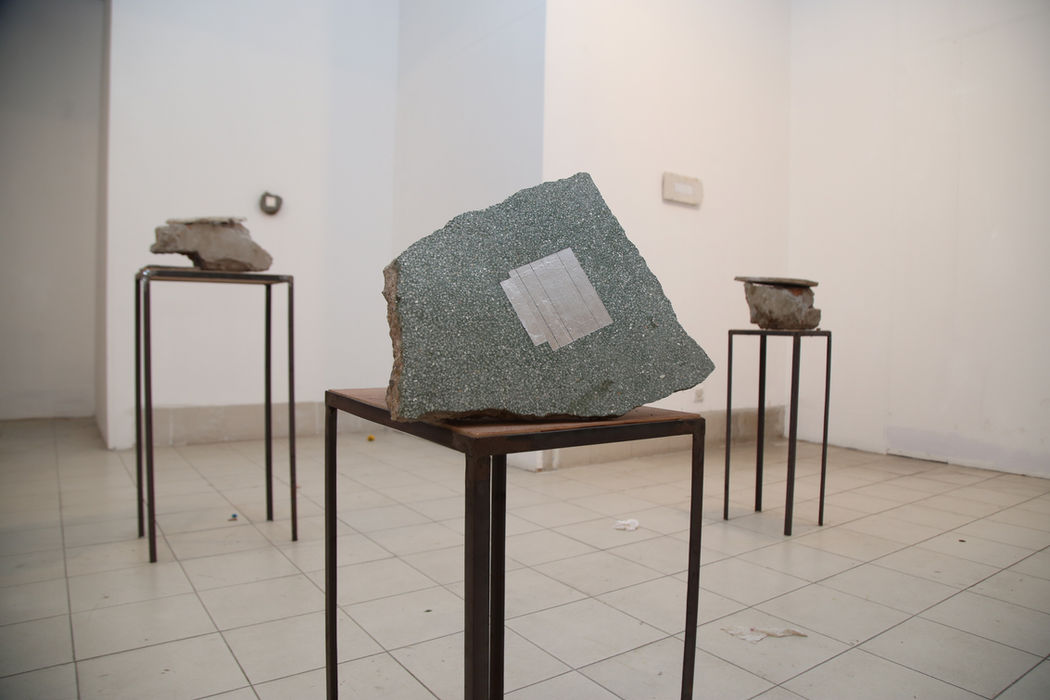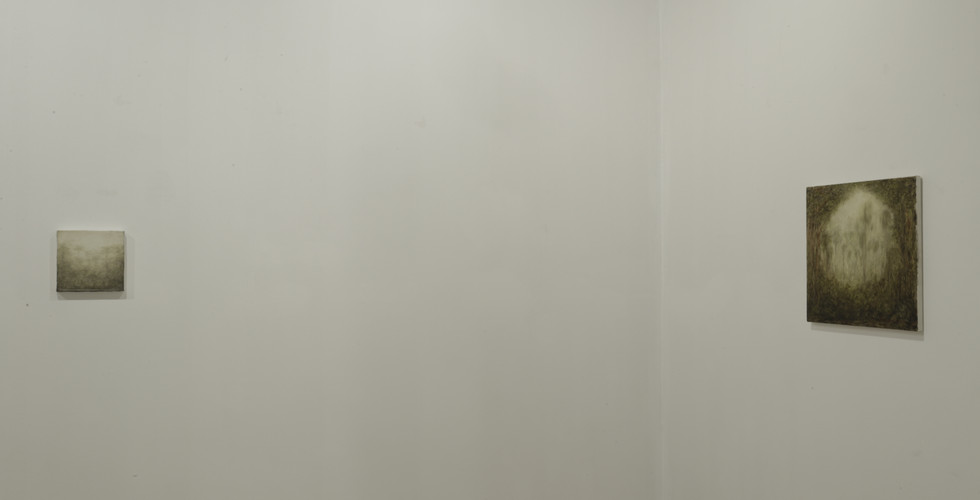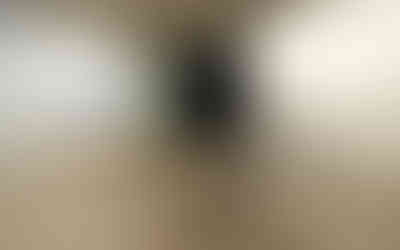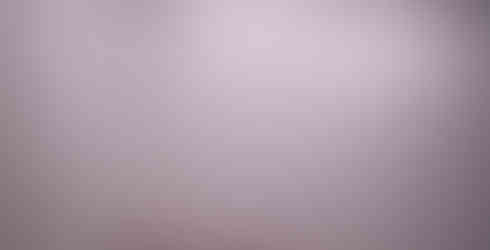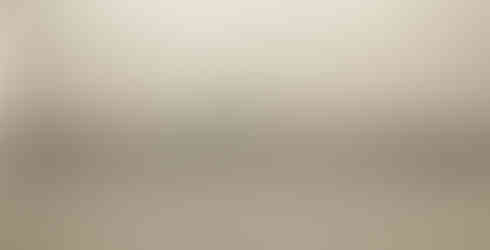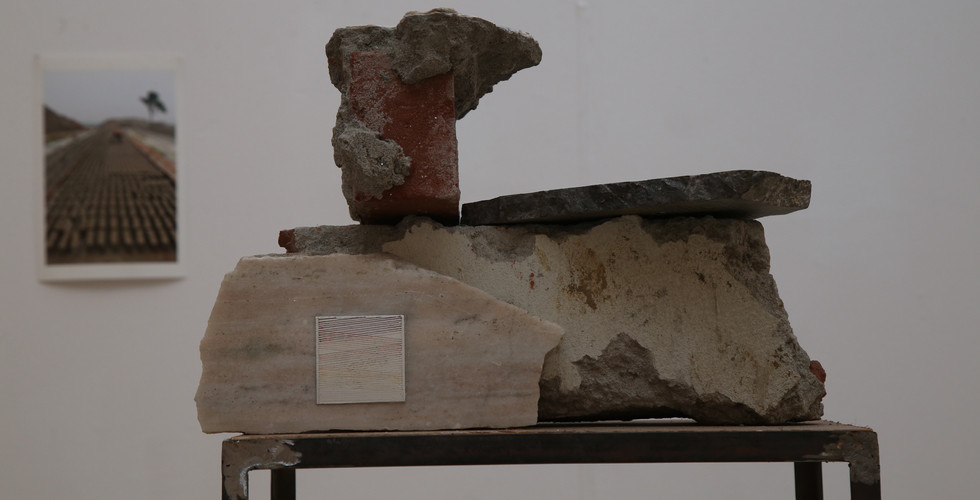Observing the interplay and occasional confrontation inherent amongarchitectural spaces within an emergent nation-state, seventeen artists/collaboratives respond to the built and unbuilt legacy of the groundbreaking Bangladeshi architect Muzharul Islam (1923–2012). Active in politics because of his own conviction that ‘it was the most architectural thing he could do’, Islam humbly and uncompromisingly forged an architectural movement in what was East Pakistan as part of a broader claim toward decolonial consciousness in the 1950s leading to the country’s independence in 1971. His buildings and ideas influenced multiple generations of Bangladeshi architects working today and subsequently international figures. Working across photography, painting, sculpture, performance, sound, and film, the artists in the exhibition present work that at once negotiates and builds worlds that are borne from the local environmental and cultural climate of Bangladesh. For Islam as well as these artists, architecture and art are conceived as benefiting all who make up the lands of any nation, no matter their origin, without the boundaries of class or caste. On Muzharul Islam: Surfacing Intention Co-Curated by Diana Campbell Betancourt with Sean Anderson and Nurur Khan and Assistant Curator Ruxmini Reckvana Q Choudhury
If the inception of the monument connoted manifestations of power, how do histories of collective agency, that which builds and/or questions the monumental, begin to be made visible? Architecture, in its capacity to embody the simultaneous recording of historical narratives in addition to marking action across time and space, extends how bodies modify, represent and experience the environment. Bangladeshi architect Muzharul Islam, born a generation prior to the partitioning of the Indian sub-continent and at work during the 1952 Language Movement and the 1971 Liberation War, was alarmed to witness attempts to transform the territory of his birth from a communal ecology grounded in culture to an alienated society in which interdependence was reduced. He deployed architecture and the assembly of physical and institutional structures as a fortress against myopic singular views of Nationhood and citizenship. While Islam believed in the strength of a Bengali identity, he also recognised how modernism as an ideology and tool could be deployed to extend the country’s influence beyond the region. Bangladesh, according to Muzharul Islam, should be conceived as modern from the beginning. In a striking departure from his predecessors, Islam’s prolific works throughout the country ensured that the pursuit of a Bangladesh-born architecture was as much concerned with signifying the multiple worlds in which the individual and society functioned while also locating oneself, a calculation of value built from within and not externally construed. Islam harnessed the diachronic histories of the built environment in Bangladesh as a means to reject proscriptive views of Bengal rooted in vernaculars. He instead refocussed how his collaborators, workers, students, and leading architects of his time including Louis I. Kahn and Stanley Tigerman could witness a Bengal of 2,000 years ago that was building large scale cities and monuments in brick as a means imagine the future of a country that did not yet exist. Muzharul Islam’s practice and ideology influenced multiple generations of Bangladeshi architects whose work has been increasingly visible internationally over the last five years. However, until recently, there has been little critical scholarly research in English about this architect who tirelessly and uncompromisingly fought to construct a new social order in cooperation with communities and partners of the land. Muzharul Islam’s conception of modernity in Bangladesh was conceived as an extension of its lands while also ensuring a way of life that was accessible to and responsive of an international community of architects, designers and artists. The production of a modern architecture in Bangladesh and more broadly, in South and Southeast Asia, expressed the potential of space with a materiality that was fluid in meaning and nature. While the introduction of concrete and cement in the region at the beginning of the 20th century promised the rise of new industrial techniques and forms, the use of brick in Bangladesh allowed for a return to the ground, to the unobstructed lands occupied for millennia by many different peoples. How brick might be conceived within modernist paradigms that privileged the multiple industries related to concrete, was crucial for an emergent nation attempting to assert its own visual and spatial identity. With an almost ontological connectivity to building, to histories in and out of time, brick remains an essential component that transcends multiple scales and contexts. Muzharul Islam’s brick architecture invests in tectonics that reconfigured how surfaces might be understood both as symbol and method. One may regard Islam’s drawings and buildings as a structuring of structures. For the architect, and the artists presented in this exhibition, contrasting (im-)materialities allow for the mutability of meaning even among precise configurations of settings. One may be able to observe how Muzharul Islam, as both an architect and an activist, revealed how communities and cultures could serve as agents in the imagining of new institutions. The conceit of the exhibition’s title reveals a paradox found within the reception of modern architecture in Bangladesh. On one hand, surfaces are both agents of and metaphors for what contains us. Buildings can be surfaces. And surfaces may embody how buildings are designed and built. Informing our visual and haptic faculties, surface is also that which collapses the negotiable nature of built space. Surfaces are a productive in-between, neither here nor there. In architecture, we are at once enmeshed among assemblies of surfaces that may have been ‘designed’ or ‘chosen’ while they are also subject to entropy, to the passage of time. By extension, the collaborative efforts for much of how Muzharul Islam’s projects transpired also allows for a questioning of labour; he built with and for the people of Bangladesh, refusing to inscribe himself as the ‘genius creator.’ Intention, likewise, is tied to internal and external processes that may broaden one’s understanding of affect. The invisible may subsequently become an index of strategies for making. Found at the horizon of the known, or perhaps at the threshold of building as object and form, intention remains ever-present, pointing a way forward, a movement toward a fragile yet more complete notion of self-knowledge. By surfacing intention, we are attempting to suggest how Muzharul Islam revealed subjectivities among his built and unbuilt projects. Consequently, the prompt for each of the artists allowed for expansive readings that are rooted in Bangladesh but also relevant to other local contexts such as Manila, Warsaw, Rio de Janeiro, New Delhi, among others. Each of the artists brought together for this exhibition use process, materiality and form to disassemble the boundaries that have long defined self and other. Conventional dialectics embedded within notions of gender and context are also questioned. In our discussions with each of the artists, how surface in all of its manifestations came to inform their own conception of Islam’s architecture was apparent. Surface was imagined as a modern agent for thinking through and responding to alternative spatial paradigms. Yet, we remained steadfast that such diverse perspectives resonate with how and why the (modern) architecture of Bangladesh might be reconceived through projection, sculpture, performance, photography, drawing and painting. What are the residues of intention? By circulating through this exhibition one participates in a journey that reveals elements of Muzharul Islam’s ideology that cannot be read by looking at an architectural plan or model. Fingerprints carry the material traces of a day’s activities and are unintended marks of our presence in a space. One of the first works visitors encounter when entering the Bangladesh Shilpakala Academy is an immersive installation on the winding central staircase of the venue choreographically built up by Rana Begum. Fingerprints of Bangladeshi collaborators of DAS come together to form a pattern of collectivity, a monument to democracy, speaking to what the hands of the people can achieve together, while maintaining the individuality of each person through the unique markings and spirals making up each fingerprint. If you look closely, similar traces of individual makers can be found on the terracotta screens and bricks of Muzharul Islam’s art school, Charukala, now formally known as the Faculty of Fine Art, University of Dhaka (designed 1953–55). Similarly, works by Ayesha Sultana, Maria Taniguchi, and Prabhavathi Meppayil measure the markings of making that build up and transform over time through processes of accumulation, oxidation, and entropy. As we pass Begum’s installation and enter Gallery One, we become enveloped in another spiralling environment of iron rebar growing from what appears to be two stairs ripped out of the central staircase of Muzharul Islam’s School of Fine Art. The climb up and down this staircase in addition to the hidden (and often forgotten) emotions from those daily journeys are part of what makes up the art history of Bangladesh, inspiring Monika Sosnowska to reimagine this element of Muzharul Islam’s architecture in a seemingly displaced sculptural form. Hajra Waheed’s video The Spiral (2019) draws us into another reading of the spiral, taking this catalytic geometry as a starting point to reflect on processes of upheaval in human experience. The video is a meditation on undefeated despair and the possibilities for radical hope that Islam fostered in his practice as Bangladesh fought for its independence. The spiral staircase in Muzharul Islam’s Charulaka winds around a column, a pivotal support structure bearing silent witness to the generations of movement around it. Tanya Goel has wrapped the pillars of the Bangladesh Shilpakala Academy’s South Plaza with Bangla resistance poems that Muzharul Islam and his peers engaged with at the dawn of Bangladesh’s existence. These texts and their florid Bangla forms painted in textured brick dust unfold as visitors circulate around these co-dependent structures which float free from obstructing walls for the first time in DAS’s exhibition history. Muzharul Islam designed his buildings with the hope that they would provide culturally grounded upward mobility for all the people passing through them in their own pursuits of knowledge. Movement is key to the works by Aditya Novali, Shezad Dawood, and Dayanita Singh in this exhibition. Novali created rotatable paintings inspired by the situated modernism of Muzharul Islam and his Indonesian contemporary, Y. B. Mangunwijaya. These paintings change form throughout the course of the show, speaking to how influence moves and shapes architecture across space and time outside of nationalist frameworks. Drawing on the futuristic geometry of Muzharul Islam’s drawings, Dawood’s adaptable ‘stage set’ functions somewhere between architecture and tapestry. For a number of years, Dawood has been developing a notion of ‘paintings without painting’, that are created through the collaging and sewing of different textile elements, some incorporating Bengali kantha techniques. These works, inspired by Islam’s plans for the University of Chittagong (1968–71), function as hangings and room dividers which envelop visitors and connect to a video that documents a dance performance realized in collaboration with choreographer Adrienne Hart, composer Patten, costume designer Priya Ahluwalia and Dawood. Dayanita Singh’s ‘Museum of Shedding’ takes the elitist form of the museum off its metaphorical pedestal and puts it in the hands of the people, where they too can become the curators, adjusting the sequence and display of the individual images within it. Institutions are dynamic mechanisms for the making of society. Like Islam and his emphasis on change from within, Dayanita’s Museums are open structures, frameworks for the making and reception of multiple meanings and audiences. While movement was crucial to Muzharul Islam, so was standing still, a necessary state of being to learn from nature and its transformations across time. The open plan of most of Muzharul Islam’s university and educational buildings speaks to how he wanted students and others alike not only to learn about art and culture within the classroom, but also from the activities teeming beyond the windows and across the roofs, verandahs, and ponds hosting other components of student life. The National Library in Dhaka has one artwork inside, a monumental mural of a jungle, and Lucas Arruda’s exquisite jungle paintings speak to a kind of knowledge that cannot be taught from books. They are embodied and yet distant; seductive yet menacing. Daniel Steegmann Mangrané’s narrative film, shot in Chaukala, looks at the spiritual interplay between humans and nonhumans and the kind of interconnected ecology that Muzharul Islam tried to foster in his work in Dhaka in the 1950s, which has ongoing lessons for other parts of the world today. The Otolith Group’s film O Horizon grounds the spirit of Dhaka’s art school in its predecessor Santiniketan in West Bengal, speaking to the wisdom its founders and architects tried to glean from its surrounding structures and forests. While the works described thus far draw inspiration from Muzharul Islam’s built spaces, many of these spaces no longer carry the architect’s intentions due to bureaucracy, degradation or ideas of modernisation that implemented elements such as air conditioners and false ceilings, obscuring the quiet majesty of his spaces. The invention of blueprints, aspects of which are used today in contemporary architectural practice, carry the scores of intentions, of what was meant to come but might never appear or what may have ceased to be. Muzharul Islam and Stanley Tigerman spent nearly ten years developing five polytechnic institutes across the country, including detailed studies into different microclimates of Bangladesh, which were never realized beyond visionary drawings and blue-prints from 1965–71. Marlon de Azambuja awakens Dhaka’s multiplicity of densities at all scales in an installation inspired by the ‘bones and organs of the city’, shifting how we consider, deploy, and imagine the clamps, bricks and tools that both Muzharul Islam and architects today imagine and construct the urban environments that contain us. Seher Shah and Randhir Singh’s cyanotype prints of Muzharul Islam’s poorly preserved Central Library at Dhaka University employ conventional architectural representational methods, such as the plan and elevation, and function between the precise formalism of a blueprint and the intuitive nature of drawing. Haroon Mirza’s animated scores of light and sound derived from Muzharul Islam’s drawings and blue-prints for Chittagong University bring to life an architectural vision for sites that would train Bangladeshis (the East Pakistanis) to develop their own destiny (even if ironically many of these projects were funded by the World Bank). Sometimes it is not possible to think or operate in a free and radical way with radical transparency, and it is necessary to remain invisible, emerging when the time is right. William Forsythe’s work, A Volume within which it is not Possible for Certain Classes of Action to Arise (2015) locates the need to find new ways of navigating spaces that constrict freedom, akin to the kinds of social spaces that Muzharul Islam tried to create within his lifetime. If previous (Western) modernist paradigms for truth-seeking were in part coalesced in and around solutions, to finality, then this exhibition attempts to reverse course, to allow for an opening, even if brief, to the possibilities afforded by architectures that may not yet be visible. These are architectures of becoming. For this exhibition, inasmuch as for the architecture of Muzharul Islam, surfacing is thus an active method for articulating simultaneities in a society’s arising, an awareness of emergent parallel historicities among movements near and far, a reshaping of value’s precarity, of collaborations borne from collectivity, each of which threatens to disturb the surface. The authors wish to thank and cite the dedicated research of the exhibition’s curatorial advisor Nurur Khan. Many of the ideas in this essay and exhibition stem from long conversations with Khan and relate to his upcoming PHD thesis.
Muzharul Islam
b. 1923, Murshidabad, British India; d. 2012, Dhaka
Muzharul Islam was an architect, urban planner, and educator and is considered to be one of the pioneers of South Asian architecture. He sought to develop a language of architectural modernism in South Asia that responded directly to the local social, cultural, and climatic conditions, while also establishing the groundwork for the development of architectural education in the region.
Islam’s architectural projects include the Faculty of Fine Arts, Dhaka University (1953–1955), the Central Public Library (1953–1954), the NIPA Building (1963–65) and the Rangamati Township (1964), Jahangirnagar University (1968–71), Chittagong University (1971), the National Library and the National Archives (1980–84). His works remain as outstanding instances of situated modernism, as well as sensitive and visionary architectural masterworks of architecture that address history, society, people, economy, city, and, foremost, the building and aspiration of a nation.
Aditya Novali
b. 1978, Surakarta; lives and works in Surakarta
Y/M/B/U/M/Z/A/H/N/A/G/R/U/U/N/L/W/I/I/S/J/L/A/A/Y/M/A #1,#2,#3,#4,#5,#6,#7,#8,#9,#10,#11,#12,#13,#14 (rotatable painting series), 2019–2020
Oil paint and ink on modular rotatable triangular zinc bars covered with canvas, wood and zinc frame
Commissioned for DAS 2020. Courtesy of the artist and Roh Projects. Realised with additional support from Roh Projects
Aditya Novali finds inspiration in the ways that Muzharul Islam (1923–2012) and the Indonesian architect Y. B. Mangunwijaya (1929–99) created spaces that provided a better quality of life for the people building the new nations of Bangladesh and his native Indonesia. For both, the ambition of architecture was in part to create transcendent opportunities for mobility across class barriers with a humanist approach. Islam and Mangunwijaya demonstrated how architecture could cross the borders of the political, social, economic, and religious realms to invent solutions for living inspired by local wisdom, especially when considering how to live in variable climates. We live in a world where many people relate more to digital information than to the immediate environment around them. In this new body of work, the artist paints rotatable panels inspired by the work of Islam and Mangunwijaya as a means to create hybrid paintings that change across the course of the exhibition, drawing connections across time, space, and cultures through the rooted legacy of these figures to their land and people.
Novali makes sculptures and installations using complex methods of production as well as commercial materials. Influenced by his background in architecture, his work addresses themes such as structure, space, and urban planning. Using audience participation, Novali’s works act as investigations of social issues related to space with the help of methodological techniques and orderly systems.
Ayesha Sultana
b. 1984 in Jessore; lives and works in Sylhet
Breath Count Series, 2019–2020
Mark-making on clay-coated paper
Courtesy of the artist, Experimenter Kolkata
and Samdani Art Foundation
Ayesha Sultana’s recent work negotiates space and distance by measuring the space between things- such as the breaks between taking breaths- marking the rhythm of the day. She contemplates the relationship between her hand, her body, and the rest of the landscape surrounding her, making visible the motion of rhythm without being seen. Through a body of scratch drawings on clay-coated paper, Breath Count are personal explorations of movement, mark-making and corporeality. Ayesha reveals staccato patterns that represent a delicate inward probe of her own body using count, distance, motion and removal in breath in these works. Like the marble lines in Louis Kahn’s parliament building, which mark the labour of a day’s work casting concrete, Sultana’s marks measure the labour of internal bodily systems.
Sultana works with drawing, painting, object, and sound, through processes that translate notions of space. She employs drawing as a tool of inquiry, through cutting, folding, stitching, layering, recording, and tracing applied to her series characterised by repetition, variation, and rhythm. Sultana often draws inspiration from architecture and the natural environment.
Daniel Steegmann Mangrané
b. 1977, Barcelona; lives and works in Rio de Janeiro
Fog Dog, 2019–2020
Film and ceramic installation
Commissioned for DAS 2020 and produced by Samdani Art Foundation and Esther Schipper. Courtesy of the artist, Samdani Art Foundation, and Esther Schipper. Presented with additional support from Mendes Wood DM
Daniel Steegmann Mangrané’s narrative film brings us into a community of human and inhuman inhabitants of Charukala, the Faculty of Fine Arts, University of Dhaka (designed by Muzharul Islam from 1953–55). Mixing fiction and contemplation, this work explores the past and future spectres that haunt present-day Bangladesh from the viewpoint of the stray dogs who live in and among its shared spaces. While life revolves around the art school for the protagonists in this film, the horrors of climactic and political violence elsewhere in the world appear and speak to the interconnectedness of seemingly disparate contexts.
Employing sculpture, installation, film, holograms, and drawing, Steegmann invites the viewer to critically reflect on how the divide between culture and nature is perceived while exploring their constructed interstices. Echoing his interest in biological systems, specifically Brazilian rainforests, Steegmann’s works often introduce elements from nature into exhibition spaces.
Dayanita Singh
What, when and where is a museum? For Dayanita Singh, the museum rests within, occasionally outside of the conventional market and aesthetic discourses that have come to instigate their articulation throughout history. One finds congruence with the institutional building projects of Muzharul Islam who actively sought to democratise spaces. For her Museum of Shedding, Singh has selected a collection of images that, with one box, suggests an origin or window into a visual and spatial language that does not seek answers. Drawn from her extensive photographic body of work, the box forms part of a series of mobile museums that allow her images to be endlessly edited, sequenced, archived and displayed. Like Muzharul Islam, the spaces that Singh has photographed are imbued with the relations, voices and rituals of their occupation. Viewers share in their unfolding. Each photograph in a Singh museum contributes to the making of unbound mythologies: of a chair, of an individual, of interiors that stand outside of time. Familiar but perhaps also unknown, Singh’s photographs and Islam’s buildings situate us in a continual state of becoming. Dayanita Singh deploys photography to reflect and expand on the ways in which we relate to photographic images and their construction. Stemming from Singh’s longstanding interest in the archive, her museums at all scales present photographs as interconnected bodies and spaces that are replete with narrative possibilities. b. 1961, New Delhi; lives and works in New Delhi
Hajra Waheed
b. 1980, Calgary; lives and works in Montreal
The Spiral, 2019
Video work with narration, 7:10 min
Courtesy of the artist. Presented with additional support from the Canada Council for the Arts
Conceived and written by Hajra Waheed as a series of working notes for an exhibition, the narration of this film explores a single form – the spiral – as a starting point to reflect on processes of upheaval in human experience. The film acts as a meditation on undefeated despair and the possibilities for radical hope. For Waheed, spirals are reflexive and interdependent, much like Muzharul Islam’s belief in the ability of architecture to bring people together to radically transform society for an equitable future.
Waheed’s multidisciplinary practice ranges from interactive installations to collage, video, sound, and sculpture. Among other issues, she explores the nexus between security, surveillance, and the covert networks of power that structure lives, while also addressing the traumas and alienation of displaced subjects affected by legacies of colonial and state violence.
Haroon Mirza
b. 1977, London; lives and works in London
Lectures in Theology, 2019–2020
24-channel electrical signals for Hi-Fi speakers and LEDs, steel, electrical wire, bespoke media device, carpet, wall painting
Commissioned and produced by Samdani Art Foundation and Lisson Gallery for DAS 2020. Courtesy of the artist, Samdani Art Foundation, and Lisson Gallery. Realised with additional
support from Lisson Gallery
How does one envision a building while also recognising its inhabitation through time and space? Even with the best of intentions, spaces change over time and often deteriorate if not maintained. This is the case with several buildings designed by Muzharul Islam, such as the Jaipurhat Limestone and Cement Project (which was built as housing for 1,700 workers and is now a girl’s military school) and the five polytechnic universities designed by Islam and Stanley Tigerman throughout Bangladesh. Architectural plans and blueprints are like scores for the future, and Haroon Mirza has composed a new sound and light installation reimagining Islam’s frequencies of thought. For both the artist and the architect, building a society relies on the ways in which education contributes to and informs how equality transcends previously encoded class divides.
Mirza’s medium is electricity, which is seen and heard simultaneously. He adopts found objects and audiovisual equipment in his installations and performances. Inviting the viewer to re-evaluate their definitions of noise and music, Mirza’s work is known for its physical impact and its undermining of straightforward narrative by exploring the sociocultural histories of the objects, ideas, and processes he employs.
Lucas Arruda
b. 1983, Sao Paulo; lives and works in Sao Paulo
Series of Untitled (from the Deserto-Modelo series), 2013–2019
Oil on canvas
Courtesy of the artist and Mendes Wood DM. Presented with additional support from Mendes Wood DM
The National Library of Bangladesh (1978–9) reflects the architect Muzharul Islam’s engagement with Louis I. Kahn. Upon entering the lobby, one immediately encounters a monumental mural of a jungle painted. This immersive and magnanimous image, an unusual choice for a library, greets those seeking knowledge while conveying Islam’s belief that learning must be grounded in the demands of climate and place. Jungles rebuild themselves as dynamic and diverse ecosystems, akin to Islam’s ideas about Bangladeshi society, which had to rebuild itself after the Pakistani army brutally massacred the country’s intellectuals in 1971. Lucas Arruda creates images that concern the body’s relationship to light throughout the day and life. Like the mural in Islam’s National Library, Arruda’s jungles coalesce a metaphysical sensation that can’t be described by scouring all the books in the library. They allude to another form of feeling and knowing.
Lucas Arruda works with painting, prints, light installation, slide projections, and films. His practice encompasses a wide spectrum of subjects, ranging from the conceptual framework of painting to metaphysical questions. Commonly portraying archetypal landscapes characterised by a subtle and intricate rendition of light, Arruda’s small-scale atmospheric compositions dwell on the viewer’s experiences as opposed to geographical specificity.
Maria Taniguchi
b. 1981 Dumaguete City; lives and works in Manila
Untitled, 2017
Acrylic on canvas
Courtesy of the artist and Samdani Art Foundation
Untitled, 2017
5 works, acrylic on canvas
Courtesy of the artist and Perrotin. Realised with additional support from Perrotin
Like Muzharul Islam, Maria Taniguchi finds beauty in the marks of the human hand on objects that we associate with industrial production, such as bricks. These traces inform not only the contexts in which they were made but also the people who made them. Taniguchi’s painted architecture calls to mind the transformative and meditative process of brick-laying as well as the subtle changes that can be found across seemingly monotonous surfaces through the movement of light and shadow. Bricks are an apt metaphor for Muzharul Islam’s philosophy that can be read as nationalism expressed through modernity. ‘When I mention standing on one’s own soil’, writes Muzharul Islam, ‘it is to find oneself, but not to find oneself and become stagnant. What I am seeking is to stand on one’s own feet and then to proceed forward. If for that reason I have to take two steps backward to go one step forward, I have no problem with that. I think that there is no other way of moving forward.’ (Islam, Muzharul. An Architect in Bangladesh: Conversations with Muzharul Islam. Edited by Kazi Khaleed. Ashraf. Dhaka: Loka Press, 2014. p.37)
Taniguchi works with painting and video in addition to printmaking, pottery, and sculpture. Her work focuses on concepts of composing, constructing, and framing, whilst referring to the craftsmanship and history of the Philippines. The repetitive process of creation employed in much of her work has been likened to the urban structure of Manila.
Marlon de Azambuja
b. 1978, Porto Alegre; lives and works in Madrid
Untitled (from the Brutalismo Series), 2019–2020
Industrial metal clamps, building material sourced in Dhaka
Commissioned for DAS 2020. Courtesy of the artist and Samdani Art Foundation and Instituto de Vision. Realised with additional support from Acción Cultural Española (AC/E)
Marlon de Azambuja’s sprawling installation captures the density of Dhaka as well as its precarity in the wake of exponential urban growth resulting from climate change-related migration. The work unveils the inner organs of the city – construction materials such as bricks and concrete blocks, industrial clamps and building tools. Like unsung artists, Bangladesh’s construction workers transform these everyday materials into the buildings that make up the cityscapes of emergent massive cities such as Dhaka. Dhaka is the world’s most densely populated city, a fact that Muzharul Islam could never have imagined when he was the senior architect for the government of East Pakistan. ‘Cities should provide the environment for civilised life within the context of our own culture,’ said Islam. ‘The city can develop only as a part of the physical environment of the country – with the ultimate aim of abolishing all differences between the city and the rural areas. The traditional relationship with nature… should be continued in the cities.’
De Azambuja works with drawing, photography, sculpture, installation, and video to create new ways of looking at the structures that surround us. He is invested in the cultural and aesthetic impact of architecture and urban planning as spaces of confrontation between instinct and rationality, and the city as a living, breathing entity.
Monika Sosnowska
b. 1972, Ryki; lives and works in Warsaw
Stairs, 2019–2020
Commissioned and Produced by Samdani Art Foundation for DAS 2020. Courtesy of the artist and Foksal Gallery Foundation
Nearly every Bangladeshi artist exhibiting at DAS 2020 has climbed up and down the spiral staircase at Charukala (the Faculty of Fine Arts) at Dhaka University as part of their artistic journey. Muzharul Islam viewed architecture as a vehicle to a better life, elevating local materials to their highest potential (while avoiding decoration). For Islam, the common Bangladeshi woman and man could rise above the circumstances in which they were born via education. Inspired by Islam and his vision, Monika Sosnowska has created a sculpture using similar materials to the staircase at Charukala, but removing its function. This sculpture leads nowhere, and while it pays homage to foundational structures, it also invites the viewer to consider the illusions inherent in built spaces.
Sosnowksa uses building elements and materials to create disorientating installations, spaces, and objects that explore the psychological impact of architectural space. She is interested in architecture’s capacity to influence behaviour as well as reflect social structures and ideologies. Flaws, glitches, and deficiencies in her work are used to question aspects commonly attributed to global modernisms.
The Otolith Group
Founded 2002 by Anjalika Sagar (b. 1968)
and Kodwo Eshun (b. 1966), who live and work
in London
O Horizon, 2018
4K video, colour, 90 min
Commissioned by Bauhaus Imaginista and co-produced by the Rubin Museum, with support from Project 88
Screening:
10am, 11.30am, 1pm, 2.30pm, 4pm, 5.30pm
O Horizon refers to the surface layer of soil, changed in the area around Santiniketan as the result of Rabindranath Tagore’s introduction of new flora to the planning and development of the campus. The film extends The Otolith Group’s ongoing consideration of the current geological age as one in which human activity spurs the primary changes on climate and the environment. O Horizon reflects upon modernist theories of dance and song developed by Tagore and the experimental practices of mural, sculpture, painting, and drawing developed by India’s great modernist artists affiliated with Santiniketan. O Horizon draws together visual arts, dance, song, music, and recital to assemble a structure of feeling of the Tagorean imagination in the 21st Century. The work also has resonances with Muzharul Islam’s campus of the Faculty of Fine Arts, University of Dhaka, where learning and convening of students unite the indoors and outdoors around circular forms such as the rooftops and ponds.
The research-based work of The Otolith Group spans moving image, audio, performance, installation, and curation. These are utilised to explore the temporal anomalies, anthropic inversions, and synthetic alienation of the posthuman, the inhuman, the nonhuman, and the complexity of the ‘environmental conditions of life we all face.’ The Otolith Group also runs a curatorial public platform, The Otolith Collective.
Prabhavathi Meppayil
b. 1965, Bangalore; lives and works in Bangalore
dp/twenty/thirteen, 2019
Copper wire and copper wire embedded in gesso panel
dp/twenty/forty eight, 2019
Wood gesso and copper
dp/twenty/six, 2019
Thinnam on gesso panel
Commissioned for DAS 2020. Courtesy of the artist and Pace. Presented with additional support from Pace
Time is rarely subtle. Yet among Prabhavathi Meppayil’s works, one’s gaze is enmeshed in a rare confluence of multiple structures, temporalities and forms that reconfigure our notion of space in and of time. At once archaeological in process and expansive in reading, Meppayil’s multimedia paintings confound for their immediacy and immeasurability. These newly commissioned works observe how Muzharul Islam’s reliance on both social and empirical structures informed the making and occupation of space. For Meppayil, her work shares in a similar layering of ideas; of an intuitive composition of sublime architectures that may be affected by forces such as entropy while at the same time, resistant to present-day desires for immediateness and easy reproduction. In this oscillation between additive and subtractive connotations, of surfaces marked and degraded, Meppayil’s works encourage the generative act of looking closely and seeing beyond.
Prabhavathi Meppayil’s practice rests in her meticulous approach to conceiving and executing processes specific to the materials that she uses. Coming from a family of goldsmiths, Meppayil adopts artisan techniques as a means to relocate particular materials as a generator of forms, providing a parallel reading to the way in which western art histories were received in the twentieth century. Through the use of non-traditional tools and often copper wire, she carves, erases and highlights carefully conceived lines and patterns into layers of gesso to underscore the blurring of painting, drawing, and other disciplines while establishing meditative installations.
Rana Begum
b. 1977, Sylhet; lives and works in London
No. 972 Wall Painting, 2019–2020
Ink and fingerprints on wall
Commissioned for DAS 2020. Courtesy of the artist and Jhaveri Contemporary. Realised with additional support from Jhaveri Contemporary
Many buildings designed by Muzharul Islam carry the marks of their makers. The architect reminded Russian-born American architect Louis I. Kahn that Bangladesh’s most skilled construction workers possessed a refined knowledge of building yet were illiterate, prompting Kahn to consider other ways of translating his vision for building in Bangladesh. In a similar spirit, writer Kazi Nasrul Islam invokes a benediction of indigenous forms of feeling and knowing in his poem Ink on My Face, Ink on my Hands. Inspired by her memories of growing up in Sylhet, Rana Begum creates an immersive participatory installation in the central staircase of DAS 2020, where the fingerprints of the individuals who come together to build DAS form an
abstract portrait of the collective energy of the Summit and city.
Begum utilises industrial materials such as stainless steel, aluminium, copper, brass, glass, and wood in her minimalist sculptures and reliefs. Her contemplative works explore shifting interactions between geometry, colour, and light, drawing inspiration from both the chance encounters of city life and the intricate patterns of Islamic art and architecture.
Seher Shah
and Randhir Singh
b. 1975, Karachi; lives and works in New Delhi
b. 1976, New Delhi; lives and works in New Delhi
Dhaka Library (set of 9), 2017–18
Cyanotype prints on Arches aquarelle paper
Commissioned and produced by Samdani Art Foundation for DAS 2018. Courtesy of the artist and Nature Morte. Presented with additional support from Nature Morte
First presented at DAS 2018, Dhaka Library is part of a collaborative body of work by Seher Shah and Randhir Singh exploring overlapping ideas in architecture, photography, drawing, and printmaking. Cyanotypes were one of the first photographic printmaking processes developed in the 19th century and a precursor to the blueprint, which was an important reproduction method for architectural and engineering drawings well into the 20th century. Working with this printmaking process, Shah and Singh focused on Muzharul Islam’s Dhaka Library (1953–1954), fragmenting its unique architectural components through photographic images. The artists were drawn to Islam’s work due to its aesthetic qualities, including heavy massing, the sculptural use of concrete, and repetitive structural grids, along with a visionary intent driven by a desire to break from the status quo.
Seher Shah’s practice uses experiences from the field of art and architecture to question the rational language of architectural drawing. Randhir Singh is an architectural photographer who draws on his education as an architect to focus on ever-changing meanings found within modern architecture and urbanism in South Asia. Over the past few years, they have collaborated on a number of projects to explore the relationships between drawing, photography, and architecture.
Shezad Dawood
b. 1974, London; lives and works in London
University of NonDualism, 2020
Installation with painted textiles and programmed lighting sequence
Musical score by patten
Commissioned for DAS 2020, generously supported by the Bagri Foundation. Courtesy of the artist and Jhaveri Contemporary
University of NonDualism, 2019
Super 8 and HD transferred to digital, 3:27 min
Commissioned by Frieze LIVE and DAS 2020, generously supported by the Bagri Foundation.
Produced by Miranda Sharp and Sara Thorsen Fredborg for Ubik Productions. Costumes by Priya Ahluwalia / Ahluwalia Studio, musical score by patten, choreography by Adrienne Hart / Neon Dance, dancers Pepa Ubera and Devaraj Thimmaiah, production by Laurie Storey, lighting by Pete Carrier, editing by Sergio Vego Borrego, location Queensrollahouse, London
Considering how the body and fabric may become architecture, and where architectural space is always a platform for human performativity, Shezad Dawood’s installation draws on the legacy of Muzharul Islam to create an adaptable stage set. His interior functions somewhere between architecture and tapestry. With the layering of sound, Dawood examines the influence of Bengali polymath Rabindranath Tagore on Muzharul Islam, but also how Tagore informed the later spiritual work of Alice Coltrane. Referencing Islam’s approach to nondualism, the project extends such flows into the space of the exhibition and enacts a series of dynamic collaborations much like the architect who regularly collaborated with artists, poets, and singers.
Dawood works across disciplines to deconstruct systems of image, language, site, and narrative. His fascination with architectural modernism in South Asia recurs in several projects, interweaving these histories with those of the Non-Aligned Movement and the Cold War. His practice often involves collaboration, imagining a remapping across geographic borders and communities.
Tanya Goel
b. 1985, New Delhi; lives and works in New Delhi
Tracing Modernity in Dust, 2019–20
Brick-dust paint
Commissioned and produced by Samdani Art Foundation for DAS 2020. Courtesy of the artist, Samdani Art Foundation, and Nature Morte. Realised with additional support from Nature Morte and Inlaks Shivdasani Foundation
The brick is perhaps the oldest and most ubiquitous building material. Tanya Goel was inspired by the detailed texture found in the brick patterns of buildings by Muzharul Islam. In designing the Faculty of Fine Arts, for example, Islam introduced a subtle geometric pattern on the face of each handmade brick, integrating a modern architectural language with the vernaculars of regional building. The artist traced details of Islam’s ageing buildings in brick dust, protecting them for the next generation through the process of drawing. She juxtaposes these zoomed in details within their wider (material) context by framing them within her photographs of Islam’s Faculty of Fine Arts, National Library, and male dormitory at Jahangirnagar University (as they stand today), paired with paintings she made on fragments of debris collected from these sites.
Goel is invested in the afterlife of construction, creating pigments from charcoal, aluminium, concrete, glass, soil, mica, graphite, and foils, all of which are sourced from building sites. Exploring abstraction within her painting practice, Goel works with the concepts of density and complexity inherent to the synthetic repetition of mathematical formulas, balancing unforeseen orders and potential chaos.
William Forsythe
b. 1949, New York
A Volume Within Which it is Not Possible for Certain Classes of Action to Arise, 2015
Scaffolding structure, drywall
Courtesy of the artist. The development and international exhibition of Choreographic Objects by William Forsythe is made possible with the generous support of Susanne Klatten
‘Choreography is about organising bodies in space, or you’re organising bodies with other bodies or a body with other bodies in an environment that is organised.’ William Forsythe
Politics ‘was the most architectural thing to do.’ Muzharul Islam
Both Muzharul Islam and William Forsythe extrapolate the tenets of their respective fields, choreography and architecture, into the realm of the political where these ideas have implications in ‘real life.’ This work is a metaphor for time, for political structures, for any physical or metaphorical barrier that might not allow for certain actions to arise. When Muzharul Islam was building the Faculty of Fine Arts and the National Library, such barriers could have been seen as colonial domination by West Pakistan. What are these barriers today? And how do they persist? This work offers the visitor the possibility of consciously and physically experiencing the loss of a broad degree of freedom, which is incorporated into our daily existence. In a world that is continuously creating impediments to movement, we must invent new strategies of transiting through them.
Forsythe is known for his radical innovations in choreography and dance. His deep interest in the fundamental principles of organisation has led him to produce a wide range of projects. Parallel to his career as a choreographer, he creates installations, film works, and interactive sculptures, known as ‘Choreographic Objects.’

